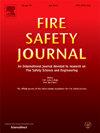火灾中膜作用下搭接对复合楼板行为的影响
IF 3.4
3区 工程技术
Q2 ENGINEERING, CIVIL
引用次数: 0
摘要
膜的作用增加了双向板的承载能力,因为增加了挠度。复合板必须在筋圈处传递足够的拉力,以确保在膜作用下有足够的承载能力。为了研究膜作用下搭接圈内拉力的传递,本文对大型钢梁与具有保证焊接点强度的钢丝网复合板楼盖系统进行了承重防火试验。网目的搭接长度为线间距加50mm (150mm),比1992-1-1规定的250mm短。根据屈服线理论,两个试件分别承受2倍或2.67倍的荷载。试件的楼板系统不仅在216 min的加热阶段,而且在冷却阶段,尽管经历了完整性破坏,但仍能抵抗荷载。焊接钢丝网温度超过600℃,最大垂直挠度为短跨的1/11。搭接圈外的导线失效,搭接圈传递了足够的拉力,直到导线屈服。因此,搭接长度的线间距加上50毫米(150毫米)是足够的,以传递张力。试验结果表明,考虑到焊接网在高温下的强度退化,基于ECCS的楼板体系的承载能力是保守的。本文章由计算机程序翻译,如有差异,请以英文原文为准。
Influence of laps on the behaviour of a composite slab under membrane action in fire
Membrane action increases the load-bearing capacity of a two-way slab due to increased deflection. The composite slab must transfer enough tensile forces at the laps of reinforcements to ensure adequate load-bearing capacity under membrane action. This study conducted load-bearing fire tests on a large-scale floor system consisting of steel beams and a composite slab with welded wire mesh of guaranteed welded point strength in order to investigate the transfer of tensile forces within the laps under the membrane action. The lap length of meshes was the wire spacing plus 50 mm (150 mm), shorter than the 250 mm specified by 1992-1-1. Two specimens were subjected to loads that were tested with either 2 or 2.67 times the predicted load based on yield line theory. The floor system of the test specimens resisted the load not only during the 216-min heating phase but also during the cooling phase, despite experiencing the integrity failure. The temperature of the welded wire mesh exceeded 600 °C, and the maximum vertical deflection was 1/11 of the short span. The wires outside the lap failed, and the laps transferred sufficient tensile forces until the wires yielded. Therefore, the lap length of the wire spacing plus 50 mm (150 mm) was adequate for transferring tensile forces. The test results indicated that the load-bearing capacity of the floor system based on ECCS was conservative, considering the strength degradation of the welded wire mesh at high temperatures.
求助全文
通过发布文献求助,成功后即可免费获取论文全文。
去求助
来源期刊

Fire Safety Journal
工程技术-材料科学:综合
CiteScore
5.70
自引率
9.70%
发文量
153
审稿时长
60 days
期刊介绍:
Fire Safety Journal is the leading publication dealing with all aspects of fire safety engineering. Its scope is purposefully wide, as it is deemed important to encourage papers from all sources within this multidisciplinary subject, thus providing a forum for its further development as a distinct engineering discipline. This is an essential step towards gaining a status equal to that enjoyed by the other engineering disciplines.
 求助内容:
求助内容: 应助结果提醒方式:
应助结果提醒方式:


